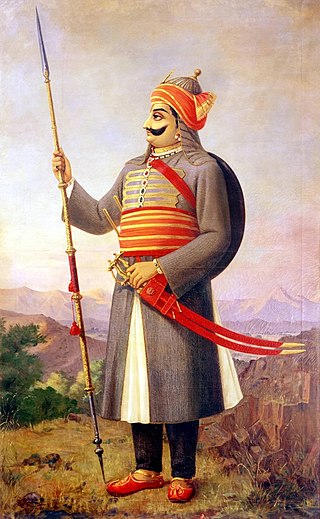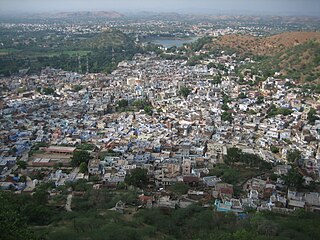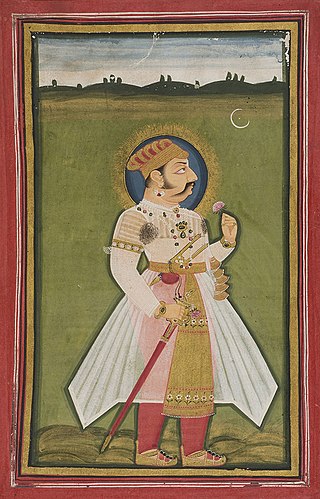
Pratap Singh I, popularly known as Maharana Pratap, was a king of Mewar, a region in north-western India in the present-day state of Rajasthan. He is notable for leading the Rajput resistance against the expansionist policy of the Mughal Emperor Akbar including the Battle of Haldighati and Battle of Dewair which have turned him into a folk hero across the country.

Chittorgarh is a major city in Rajasthan state of western India. It lies on the Berach River, a tributary of the Banas, and is the administrative headquarters of Chittorgarh District. It was a major stronghold of the Rajput State of Medapata. The city of Chittorgarh is located on the banks of river Gambhiri and Berach.

Dungarpur is a city in the southernmost part of Rajasthan, India. It is the administrative headquarters of Dungarpur District. It is the fastest developing town in the southern part of Rajasthan, alongside Aspur tehsil.
Gogunda is a town and tehsil headquarters of Gogunda Tehsil in Udaipur district, located about 35 km (22 mi) in north-west from Udaipur city in the Indian state of Rajasthan. It is situated on a high mountain in Aravalli hills and is reached by crossing a difficult mountain pass.

Kumbhakarna Singh, popularly known as Maharana Kumbha, was the Maharana of the Kingdom of Mewar in India. He belonged to the Sisodia clan of Rajputs. It was during his reign that Mewar became one of the most powerful powers in the northern India. He was the most powerful sovereign of his time.
Shahpura is a town and district headquarters of Shahpura district, near the city of Bhilwara, in the Indian state of Rajasthan. It was made a district on 17 March 2023.

The Battle of Haldighati was a battle fought on 18 June 1576 between the Mewar forces led by Maharana Pratap, and the Mughal forces led by Man Singh I of Amber. The Mughals carried the day after inflicting significant casualties on Mewar forces, although they failed to capture Pratap, who reluctantly retreated persuaded by his fellow commanders.
Amet is a town and a municipality located in Rajsamand district in the Indian state of Rajasthan.
Bari Sadri is a town and a municipality in Chittaurgarh district in the state of Rajasthan, India.
Begun is a city and a municipality in Chittaurgarh district in the state of Rajasthan, India. Begun was offered along with Gothlai to Chunda ji, who renounced his right to the throne for his brother Rana Mokal in 15th century. Since then, Begun was ruled by Chundawat Sisodia Rajputs of Mewar. It is also one of the historical towns of Chittorgarh district. One of Mewar's important rivers, Brahmani, flows through Begun. Begun also has a fort which is surrounded by a small river.
Jahazpur is a city and a municipality in Bhilwara district in the Indian state of Rajasthan. It is also the tehsil headquarters of the Jahazpur tehsil. It is commonly popular for a temple called Jain temple swastidham, built around a fort.
Sarangpur is a city and tehsil in Rajgarh district in the Indian state of Madhya Pradesh. It is situated at the bank of the river Kali Sindh.

Udai Singh II was the Maharana of Mewar and the founder of the city of Udaipur in the present-day Rajasthan state of India. He was the 12th ruler of the Kingdom of Mewar. He was the fourth son of Rana Sanga and Rani Karnavati, a princess of Bundi.

The Kingdom of Mewar, sometimes known as Udaipur State, was an independent kingdom in Rajputana region of India, ruled by the Sisodia dynasty. It was established around the 7th century by the minor rulers of the Nagada-Ahar region of Udaipur and later, in the 10th century, it transformed into an independent state under Rawal Bharttripatta II.
Devi Garh Palace is a heritage hotel and resort, housed in the 18th-century Devi Garh palace in the village of Delwara. It was the royal residence of the rulers of Delwara principality, from the mid-18th century till the mid-20th century. Situated in the Aravalli hills, 28 km northeast of Udaipur, Rajasthan, Devigarh forms one of the three main passes into the valley of Udaipur.

Maharana Amar Singh I, the Maharana of Mewar, was the eldest son and successor of Maharana Pratap of Mewar. He was the 14th Rana of Mewar dynasty of Sisodia Rajputs and ruler of Mewar from January 19, 1597 till his death on January 26, 1620. His capital was Udaipur.
The Battle of Mandalgarh and Banas were two major battles fought between Rana Kumbha of Mewar and Mahmud Khalji of Malwa which resulted in decisive defeat of the latter.

Karamchand Bachhawat (1542-1607) (विभूति) was the Dewan, Prime Minister of Bikaner State in the former Rajputana from 1571 to 1591. Karamchand, a descendant of Bachhraj, was a valiant warrior, a good administrator and a strategist in Bikaner and had a good relationship with Akbar. In 1591, fearing for his life, he resigned. At Akbar's invitation, Karamchand later joined the emperor as an adviser to the Lahore court. If you look at history, it has always celebrated the lives of the kings or emperors of an era but carries very little information about the those supportive of them, who stood serving a purpose. Behind every king are unsung nobles, who acted as pillars of support. Karamchand Bachhawat is one such person.
Delwara, nestled in the Aravalli Range hills, is a small town about 28 kms away from Udaipur, Mewar, and close to Eklingji Temple, on the way to the temple town of Nathdwara, in the state of Rajasthan, India. Delwara was originally known as ‘Devkul Patan Nagri’, which means the town of god. It boasted over 1500 temples at one time, out of which there were over 400 Jain temples. Delwara was the center of learning and culture before the 15th century AD. Around the middle of the 13th century, Raja Sagar, a Deora Chauhan and a descendant of Rao Kirtipal of Jalore, was a very brave king of Delwara (Mewar). Descendants of Raja Sagar sacrificed their lives whilst fighting alongside Ranas of Mewar against Muslim invaders. Raja Sagar was the progenitor of Bachhawat and Bothra clan of Oswals. Sagar's son, Kunwar Bohitya was immensely influenced and inspired by Jain philosophy. Samdhar, a grandson of Bohitya and a Deora Chauhan, was the first man in his genealogy to convert to Jainism.










